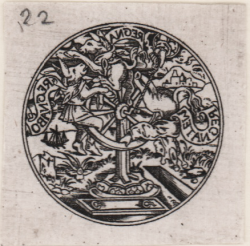



| Reference: | s39959 |
| Author | Anonimo |
| Year: | 1795 ca. |
| Measures: | 35 x 40 mm |


| Reference: | s39959 |
| Author | Anonimo |
| Year: | 1795 ca. |
| Measures: | 35 x 40 mm |
Copy of a niello print formerly kept in the Durazzo collection (n. 2854), now in Berlin, Staatliche Museen.
On the scrolls, clockwise from the left, in reverse: REGNABO, REGNA, REGNATEM.
This fine, delicately engraved work is characteristic of niello prints in its diminutive size, its circular shape, and its inscription in reverse, but uncharacteristic in its white, unshaded background. Technically, it appears to date from the late fifteenth or early sixteenth century.
The subject was common throughout European art from the high middle ages onward and is often accompanied by variants of the inscriptions quoted above, each one associated with a different figure placed at regular intervals around Fortune’s wheel.
In this image, the wheel is turned by a rope, attached to a crank in the center and pulled by a hand emerging from the sky at the upper right. The hand appears to emerge from, or pass through, a halo inscribed with a cross. The hand, therefore, must be the hand of God, who determines man’s fate by propelling the Wheel of Fortune.
The nielli of the Durazzo collection were reproduced in engravings by the owner himself, between the end of the 18th and the beginning of the 19th century, in Venice - as also specified by Malaspina in his catalog of 1824 - constituting a series that was circulated and collected by amateurs. Bartsch describes these copies in his volume published in 1811, a date that therefore constitutes the terminus ante quem for the execution. For the attribution to Maso Finiguerra, disputed by some scholars, see the summary in Zucker in The Illustrated Bartch,1993.
|
TIB 2401.011; Duchesne, pp. 259-60, n. 312; Zanetti, p. 107, n. 151
|
Anonimo
|
TIB 2401.011; Duchesne, pp. 259-60, n. 312; Zanetti, p. 107, n. 151
|
Anonimo